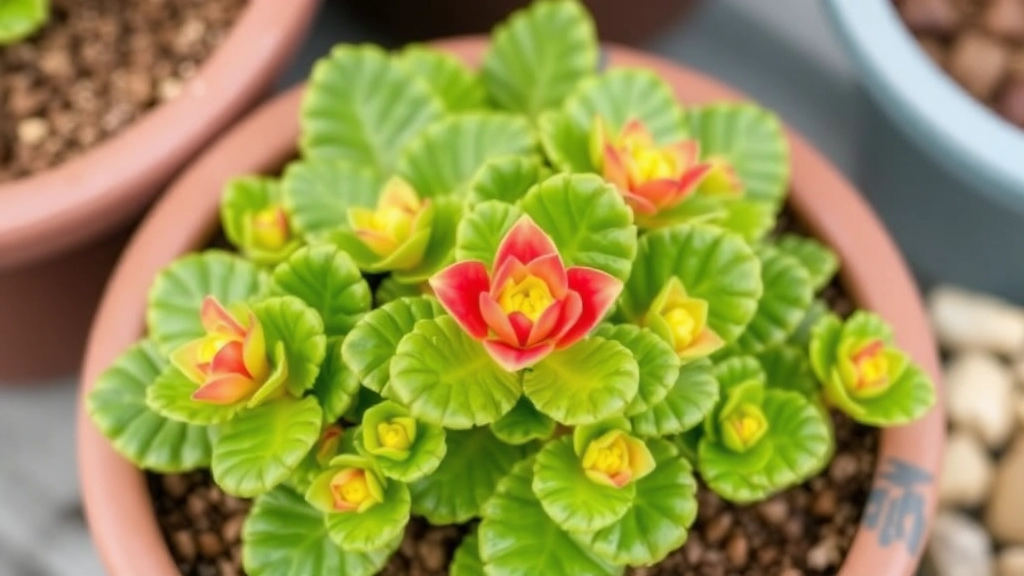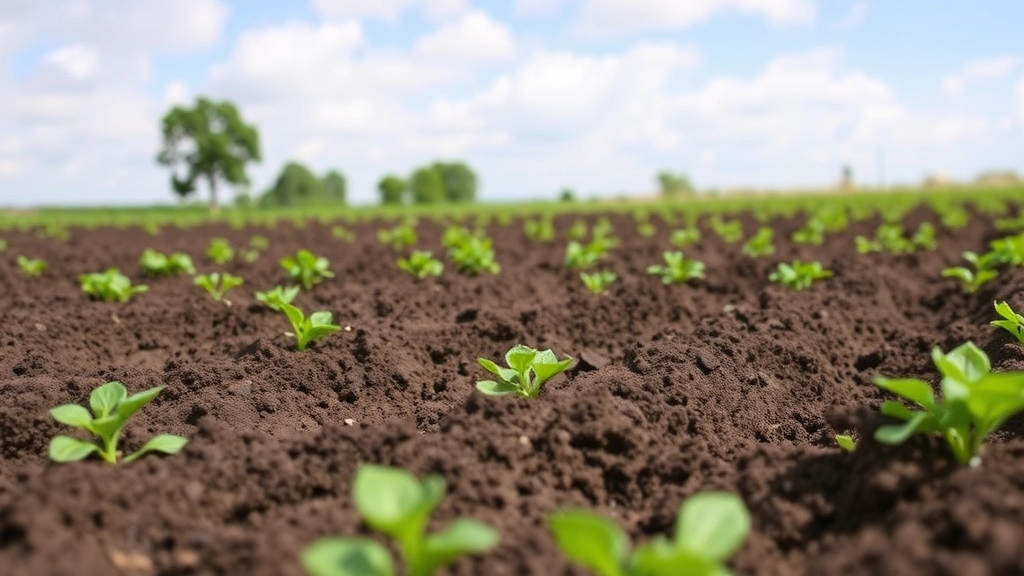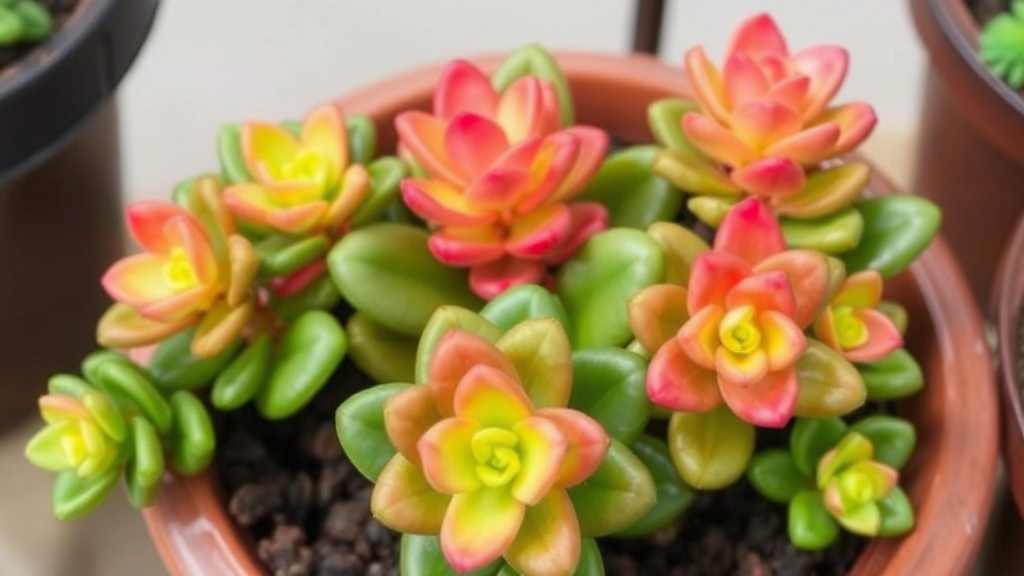As a florist with a passion for kalanchoe plants
I’m excited to share my expert tips on caring for these vibrant succulents. In this comprehensive guide, we’ll explore everything from selecting the perfect kalanchoe to mastering watering techniques and encouraging those stunning blooms. Whether you’re a seasoned plant parent or just starting your green thumb journey, you’ll find valuable insights to help your kalanchoe thrive.
We’ll dive into ideal growing conditions, soil and fertilization needs, and troubleshooting common issues
I’ll also reveal my secret tricks for propagation and seasonal care that will have your kalanchoe flourishing year-round. Get ready to transform your space with these colorful, low-maintenance beauties – let’s embark on this kalanchoe care adventure together!
Choosing the Right Kalanchoe Plant
Alright, let’s dive into choosing the right Kalanchoe plant. This is where the fun begins, folks!
Ever stood in front of a sea of Kalanchoe plants, feeling a bit lost? Yeah, been there. Let’s break this down and make it dead simple.
What to Look For:
- Healthy Leaves: You want leaves that are thick, fleshy, and vibrant. No yellow or brown spots – that’s a red flag.
- Compact Growth: A bushy plant is a happy plant. Avoid the leggy ones; they’re probably reaching for more light.
- Flower Power: If it’s blooming, check out those flowers. They should be perky and colourful, not wilting or dropping petals.
- Root Check: Gently slip the plant out of its pot. Healthy roots are white or light-coloured. If they’re dark or mushy, walk away.
Here’s a pro tip: Don’t always go for the one in full bloom. Sometimes, a plant with lots of buds is a better bet. You’ll get to enjoy the whole show!
Types to Consider:
- Kalanchoe blossfeldiana: The classic. Great for beginners.
- Kalanchoe tomentosa (Panda Plant): Fuzzy leaves, super cute.
- Kalanchoe thyrsiflora (Flapjack): Massive paddle-shaped leaves. A real eye-catcher.
Remember, choosing a Kalanchoe is like picking a new flatmate. You want one that fits your lifestyle and space. Don’t rush it!
Questions to Ask Yourself:
- How much light does my space get?
- Am I a serial over-waterer or do I forget plants exist?
- Do I want a flowering show or just cool foliage?
Answering these will help you zero in on the perfect Kalanchoe for you.
Bottom line: Picking the right Kalanchoe plant sets you up for success. It’s the first step in your journey to becoming a Kalanchoe guru. Trust your gut, and don’t be afraid to ask the staff for help. They’ve seen it all!
Ideal Growing Conditions for Kalanchoe

Alright, let’s chat about getting your Kalanchoe to thrive.
These succulents are pretty chill, but they’ve got their preferences.
Light
- Bright, indirect sunlight is their jam
- 4-6 hours of sun daily keeps ’em happy
- Too much direct sun? They’ll get crispy leaves
Temperature
- They’re not fans of the cold
- Aim for 15-25°C (60-75°F)
- Below 10°C (50°F)? Bring ’em inside, pronto
Humidity
- Average room humidity works fine
- No need for misting or humidifiers here
Soil
- Well-draining is key
- Mix potting soil with sand or perlite
- Soggy roots are a no-go
Space
- They’re not space hogs
- A small pot with drainage holes does the trick
Remember, Kalanchoes are tough cookies.
They’ll forgive a bit of neglect, but give ’em these conditions, and they’ll reward you with stunning blooms. If you’re growing a Kalanchoe blossfeldiana, you’ll be amazed by its vibrant flowers.
Got any Kalanchoe growing stories? I’d love to hear ’em! And if you’re interested in a unique variety, check out the Kalanchoe tomentosa white for its distinctive fuzzy leaves.
Watering Requirements and Techniques
Alright, let’s dive into watering your Kalanchoe – it’s not rocket science, but get it wrong, and you’re in for a world of plant drama.
First things first: Kalanchoes are succulents, which means they’re like that friend who’s always saying, “Nah, I’m good” when you offer them a drink. They’re not big on water, and overwatering is their kryptonite.
So, how often should you water?
Here’s the deal:
- Water when the top inch of soil feels dry to the touch
- In summer, this might be once a week
- In winter, you’re looking at every 2-3 weeks
But here’s the kicker – it’s not just about frequency. It’s about technique too.
Watering Techniques:
1. The Soak and Dry Method
This is my go-to. It’s like giving your Kalanchoe a proper drink instead of just a sip. Here’s how:
- Water thoroughly until it runs out the drainage holes
- Let it drain completely
- Don’t water again until the soil’s dry
2. Bottom Watering
Sometimes, I like to mix it up with this method:
- Place the pot in a tray of water
- Let it soak for about 15 minutes
- Remove and let it drain
Why do this? It encourages deeper root growth. Plus, it’s like a spa day for your plant.
Common Watering Mistakes:
Look, we’ve all been there. You get a bit overzealous with the watering can, and suddenly your Kalanchoe’s looking sadder than a wet cat. Here are some pitfalls to avoid:
- Overwatering: This is the big one. Too much water leads to root rot, and that’s a one-way ticket to plant heaven.
- Using a spray bottle: Kalanchoes don’t like wet leaves. It’s not a rainforest plant, folks.
- Watering on a schedule: Plants don’t wear watches. Check the soil, not the calendar.
Pro Tip: If you’re not sure whether to water, wait an extra day. These plants are tougher than they look.
Remember, watering your Kalanchoe right is key to keeping it happy and healthy. It’s not about drowning it in love (or water), it’s about giving it what it needs when it needs it. Get this right, and you’ll have a thriving plant that’ll make your green-thumbed friends green with envy.
Soil and Fertilization Needs

Let’s chat about what your Kalanchoe plants are craving in terms of soil and food.
Soil: The Secret Sauce
These succulents aren’t fussy, but they do have preferences:
- Well-draining soil is a must
- Mix regular potting soil with sand or perlite
- Aim for a 50/50 blend
- Avoid heavy, water-retaining soils
Why? Kalanchoes hate wet feet. Trust me, I learned this the hard way.
Feeding Time: Less is More
Kalanchoes aren’t big eaters. Here’s the lowdown:
- Use a balanced, water-soluble fertilizer
- Feed every 2-3 months during growing season
- Skip fertilizing in winter
- Dilute to half-strength to avoid overfeeding
Pro tip: If your plant’s looking a bit peaky, don’t rush to feed it. Often, less is more with these beauties.
pH Matters
Kalanchoes prefer slightly acidic to neutral soil:
- Aim for a pH between 5.8 and 6.5
- Test your soil occasionally
- Adjust with lime or sulfur if needed
Remember, happy soil means happy plants. Get this right, and your Kalanchoe blossfeldiana will thank you with gorgeous blooms. If you’re interested in a unique variety, the Kalanchoe beharensis also thrives under similar soil conditions.
Light and Temperature Preferences
Alright, let’s chat about what makes Kalanchoe plants tick when it comes to light and temp. These succulents are pretty chill, but they’ve got their preferences, you know?
Lighting: The Goldilocks Zone
Kalanchoes are sun-lovers, but they’re not trying to get a tan. Here’s the deal:
- Bright, indirect light is their sweet spot
- 4-6 hours of sunlight daily keeps ’em happy
- Too much direct sun? They’ll get sunburnt (yep, plants can burn too)
- Not enough light? Say goodbye to those gorgeous blooms
Pro tip: If your Kalanchoe’s looking a bit pale or stretchy, it’s probably begging for more light. Move it closer to a window, but not right in the sun’s firing line.
Temperature: Keeping It Cosy
These plants aren’t big fans of extreme temps. They’re more of a “room temperature” kind of crowd:
- Ideal range: 15-25°C (60-75°F)
- Can handle a bit cooler at night
- Anything below 10°C (50°F)? That’s a no-go zone
Here’s the thing: Kalanchoes are tough cookies, but they’re not invincible. I once left mine on the windowsill during a cold snap – big mistake. The poor thing looked like it had been through the wringer.
Seasonal Shifts
As the seasons change, so should your Kalanchoe’s spot in your home:
- Summer: Keep ’em away from scorching windows
- Winter: Move closer to light sources, but watch out for drafts
Remember, these plants are native to Madagascar. They’re used to warm, bright conditions, but not extreme heat or cold. Think “tropical holiday” vibes, not “desert expedition” or “arctic adventure”.
The Bottom Line
Getting the light and temp right for your Kalanchoe isn’t rocket science. Just imagine what you’d want if you were a plant from a tropical island – plenty of bright light, but not too harsh, and a nice, steady warmth. Nail that, and your Kalanchoe will be living its best life, showing off those vibrant blooms like it’s nobody’s business.
Pruning isn’t just for show – it’s a game-changer for your plant’s health. Here’s the lowdown on pruning and maintenance for your Kalanchoe blossfeldiana:
Timing is everything:
⢠Prune after flowering
⢠Snip away dead or yellowing leaves anytime
Grab your scissors:
⢠Use clean, sharp pruning shears
⢠Make cuts just above a leaf node
Shape it up:
⢠Trim back leggy stems to encourage bushiness
⢠Don’t go overboard – remove no more than 1/3 of the plant
Deadheading magic:
⢠Pinch off spent blooms
⢠This trick keeps your Kalanchoe flowering longer
Maintenance musts:
⢠Dust leaves gently with a damp cloth
⢠Check for pests regularly
⢠Rotate the pot for even growth
Pro tip: Save those cuttings for propagation – more Kalanchoes for free!
Remember, a little TLC goes a long way. Your florist Kalanchoe plant will thank you with lush growth and vibrant blooms.
Got any pruning horror stories? We’ve all been there. Share in the comments!
Common Pests and Diseases
Let’s chat about the not-so-fun part of growing Kalanchoes – the pesky critters and plant problems that can pop up. Trust me, I’ve seen my fair share of these issues, and I’m here to help you tackle them head-on.
Creepy Crawlies to Watch Out For
- Mealybugs: These little cotton-ball lookalikes love to suck the life out of your Kalanchoe.
- Spider mites: Tiny but mighty, these guys can cause serious damage if left unchecked.
- Aphids: Small, soft-bodied insects that cluster on new growth and suck plant sap.
Plant Problems That Might Crop Up
- Root rot: This is a biggie, especially if you’re heavy-handed with the watering can.
- Powdery mildew: A white, powdery fungus that can spread quickly in humid conditions.
- Leaf spot: Brown or black spots on leaves that can lead to leaf drop if not addressed.
Dealing with These Troublemakers
Here’s the deal – prevention is your best mate when it comes to pests and diseases. Keep your Kalanchoe healthy, and it’ll be better equipped to fight off invaders. But if you do spot trouble, don’t panic! Here’s what you can do:
- Isolate the affected plant to prevent spread.
- For pests, try wiping them off with a cotton swab dipped in rubbing alcohol.
- Prune away any diseased parts and improve air circulation around the plant.
- As a last resort, use organic pesticides or fungicides.
Remember, keeping an eye on your Kalanchoe is key. Catch these issues early, and you’ll save yourself a lot of headache down the road. And hey, don’t be too hard on yourself if problems crop up – even the most experienced plant parents face these challenges.
So, stay vigilant, act fast, and your Kalanchoe will thank you by staying healthy and vibrant. Keep an eye out for these common pests and diseases, and you’ll be well on your way to mastering Kalanchoe care.
Propagation Methods for Kalanchoe

Ever wondered how to get more of these gorgeous succulents? Let’s chat about propagating Kalanchoe.
It’s easier than you might think, and I’ve got some tricks up my sleeve.
Leaf Cuttings: The Lazy Way
Grab a healthy leaf, let it dry for a day or two.
Pop it on some well-draining soil.
Mist occasionally and watch the magic happen.
Stem Cuttings: The Quick Route
Snip a stem about 4 inches long.
Remove lower leaves, let it callous over.
Stick it in soil, keep it slightly moist.
Division: For the Impatient Gardener
Got a big Kalanchoe? Lucky you!
Gently separate the roots into smaller plants.
Replant and treat ’em like royalty.
Water Propagation: The Show-Off Method
Cut a stem, pop it in water.
Change water weekly, watch roots grow.
Plant in soil once roots are an inch long.
Tips for Success:
- Use clean, sharp tools to avoid infections.
- Be patient – good things take time.
- Keep propagated plants warm and bright, but out of direct sun.
Remember, propagation’s a bit like cooking – sometimes you nail it, sometimes you don’t.
But that’s the fun of it, right?
Give it a go and before you know it, you’ll have Kalanchoe varieties coming out of your ears! And if you’re looking for a specific type to propagate, why not try the florist Kalanchoe plant? It’s a popular choice for its beautiful blooms.
Seasonal Care and Flowering
Alright, let’s chat about keeping your Kalanchoe happy all year round and getting those gorgeous blooms. Trust me, it’s not rocket science, but there are a few tricks up my sleeve that’ll make your plant the envy of the neighbourhood.
Seasonal Shifts: What’s the Deal?
First things first, Kalanchoes are tough cookies. They can handle a bit of everything, but they’ve got their preferences. Here’s the lowdown:
Spring: Time to Wake Up!
- Gradually increase watering
- Start fertilising (but don’t go crazy)
- Move to a brighter spot if it’s been in low light
Summer: Livin’ It Up
- Water more frequently (but don’t drown it!)
- Protect from scorching midday sun
- Watch out for pests – they love the warm weather too
Autumn: Prepping for the Chill
- Reduce watering
- Stop fertilising
- Move to a cooler spot to encourage blooming
Winter: Cosy Time
- Water sparingly
- Keep away from cold drafts
- Provide bright, indirect light
Getting Those Blooms: The Secret Sauce
Now, here’s where it gets interesting. Kalanchoes are short-day plants. What’s that mean? They need long nights to trigger flowering. Sounds backwards, right? But trust me, it works.
Here’s my foolproof method:
- In autumn, give your Kalanchoe 14 hours of uninterrupted darkness each night
- Do this for about 6 weeks
- Keep the temperature cool (around 15°C)
- Be patient – blooms will appear in about 6-8 weeks
Pro Tip: If you’re impatient like me, you can trick your Kalanchoe into blooming off-season. Just mimic those autumn conditions any time of year. I’ve had Kalanchoes blooming at Christmas – talk about a conversation starter!
Troubleshooting: When Things Go Sideways
Not seeing flowers? Don’t panic. Here are some common issues:
- Too much light during dark periods
- Temperatures too high
- Overwatering (a classic mistake)
- Not enough nutrients
Remember, Kalanchoes are pretty forgiving. If you mess up, just adjust and try again. They’re not drama queens like some other plants (looking at you, orchids).
Wrapping It Up
Seasonal care for Kalanchoes isn’t rocket science, but it does require a bit of attention. Get the basics right – light, water, temperature – and you’re golden. And when it comes to flowering, just remember: long nights, cool temps, and a bit of patience. Nail that, and you’ll have a Kalanchoe that’s the talk of the town. Now go forth and grow, my friend!
Troubleshooting Common Issues
Hey there, Kalanchoe enthusiasts! Let’s chat about some hiccups you might face with these beauties.
Yellowing leaves? Don’t panic!
It’s usually down to overwatering or poor drainage. Easy fix: ease up on the H2O and check that soil.
Leggy plants stretching for the sky?
They’re crying out for more light. Scoot ’em closer to a window, but watch out for scorching.
Flower power fading fast?
Could be too much shade or not enough nutrients. A bit of fertiliser and a sunnier spot might do the trick.
Droopy leaves?
Might be thirsty or suffering from root rot. Give the soil a poke – if it’s bone dry, water it. If it’s soggy, let it dry out.
Spots on leaves?
Could be fungal. Snip off affected bits and improve air circulation. Maybe lay off the overhead watering for a bit.
No flowers in sight?
Patience, my friend. Kalanchoes need specific light cycles to bloom. Give ’em 14 hours of darkness daily for a few weeks.
Brown, crispy leaf edges?
Likely sunburn or low humidity. Move away from direct sun and mist occasionally.
Bugs throwing a party on your plant?
Wipe leaves with soapy water or neem oil. Repeat weekly until the uninvited guests leave.
Remember, most Kalanchoe issues are easy to sort. Keep an eye on your plant, adjust care as needed, and you’ll be golden.
Got any Kalanchoe troubles I missed? Drop a comment and let’s troubleshoot together!
Frequently Asked Questions about Florist Kalanchoe Plant Care
How often should I water my Kalanchoe plant?
Water your Kalanchoe when the top inch of soil feels dry to the touch. This typically means watering once a week in summer and every 2-3 weeks in winter. Remember, it’s better to underwater than overwater these succulents.
What kind of light does a Kalanchoe need?
Kalanchoes thrive in bright, indirect sunlight. Aim for 4-6 hours of sunlight daily. Too much direct sun can scorch the leaves, while too little light can result in leggy growth and fewer blooms.
How can I get my Kalanchoe to bloom again?
To encourage blooming, provide your Kalanchoe with 14 hours of uninterrupted darkness each night for about 6 weeks. Keep the temperature cool (around 15°C) during this period. Blooms should appear in 6-8 weeks.
What’s the best soil for Kalanchoe plants?
Use a well-draining potting mix. A good blend is 50% regular potting soil and 50% sand or perlite. This ensures good drainage and prevents root rot.
How do I propagate my Kalanchoe?
Kalanchoes can be easily propagated through leaf or stem cuttings. Allow the cuttings to dry for a day or two, then plant them in well-draining soil. Keep the soil slightly moist until roots develop.
Why are my Kalanchoe’s leaves turning yellow?
Yellowing leaves are often a sign of overwatering or poor drainage. Reduce watering frequency and ensure your pot has adequate drainage holes. If the problem persists, check for root rot.
How often should I fertilize my Kalanchoe?
Fertilize your Kalanchoe every 2-3 months during the growing season with a balanced, water-soluble fertilizer diluted to half strength. Avoid fertilizing in winter when the plant is dormant.
Can Kalanchoes be grown outdoors?
Yes, Kalanchoes can be grown outdoors in regions with mild climates. They prefer temperatures between 15-25°C (60-75°F) and should be protected from frost. If you live in a colder area, grow them in containers that can be moved indoors during winter.
References
-
University of Florida IFAS Extension – Kalanchoe blossfeldiana Kalanchoe blossfeldiana Poelln., Kalanchoe
-
Missouri Botanical Garden – Kalanchoe blossfeldiana Kalanchoe blossfeldiana
-
North Carolina State University Cooperative Extension – Kalanchoe Kalanchoe blossfeldiana

